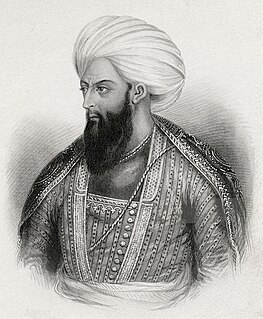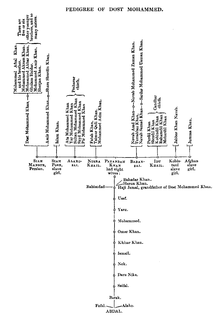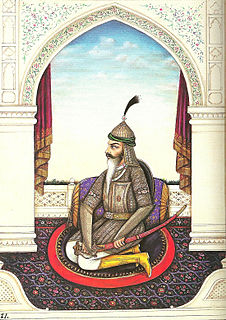
The Durrani Empire, also called the Sadozai Kingdom and the Afghan Empire, was founded and built by Ahmad Shah Abdali in parts of Central Asia, Middle East and South Asia. At its maximum extent, the empire ruled over the modern-day countries of Afghanistan and Pakistan, as well as parts of northeastern and southeastern Iran, eastern Turkmenistan, and northwestern India.

Dost Mohammad Khan was the founder of the Barakzai dynasty and one of the prominent rulers of Afghanistan during the First Anglo-Afghan War. With the decline of the Durrani dynasty, he became Emir of Afghanistan from 1823 to 1839 and then from 1843 to 1863. An ethnic Pashtun, he was the 11th son of Sardar Payendah Khan who was killed in 1799 by Zaman Shah Durrani. At the start of his rule in March 1823, the Afghans lost their former stronghold of Peshawar Valley to the Sikh Khalsa Army of Ranjit Singh at the Battle of Nowshera. The Afghan forces in the battle were supported by Azim Khan, half-brother of Dost Mohammad Khan.

Maharaja Ranjit Singh, popularly known as Sher-e-Punjab or "Lion of Punjab", was the leader of the Sikh Empire, which ruled the northwest Indian subcontinent in the early half of the 19th century. He survived smallpox in infancy but lost sight in his left eye. He fought his first battle alongside his father at age 10. After his father died, he fought several wars to expel the Afghans in his teenage years and was proclaimed as the "Maharaja of Punjab" at age 21. His empire grew in the Punjab region under his leadership through 1839.

The Second Anglo-Sikh War was a military conflict between the Sikh Empire and the British East India Company that took place in 1848 and 1849. It resulted in the fall of the Sikh Empire, and the annexation of the Punjab and what subsequently became the North-West Frontier Province, by the East India Company.

Sardar Mohd. Azim Khan Barakzai was a Pashtun noble who served as Afghan governor of Kashmir (1812–1819). He was the second son of the Barakzai chief Payendah 'Sarfraz' Khan, while his elder brother Fatteh Khan was kingmaker and Vizier to Mahmud Shah Durrani. He was one of 21 brothers from eight mothers including his half-brother Dost Mohammad Khan who would later become Emir of Afghanistan.

The Sikh Empire was a state originating in the Indian subcontinent, formed under the leadership of Maharaja Ranjit Singh, who established an empire based in the Punjab. The empire existed from 1799, when Maharaja Ranjit Singh captured Lahore, to 1849 and was forged on the foundations of the Khalsa from a collection of autonomous Sikh misls. At its peak in the 19th century, the Empire extended from the Khyber Pass in the west to western Tibet in the east, and from Mithankot in the south to Kashmir in the north. Religiously diverse, with an estimated population of 3.5 million in 1831, it was the last major region of the Indian subcontinent to be annexed by the British Empire.

Hari Singh Nalwa (1791–1837) was Commander-in-chief of the Sikh Khalsa Fauj, the army of the Sikh Empire. He is known for his role in the conquests of Kasur, Sialkot, Attock, Multan, Kashmir, Peshawar and Jamrud. Hari Singh Nalwa was responsible for expanding the frontier of Sikh Empire to beyond the Indus River right up to the mouth of the Khyber Pass. At the time of his death, the western boundary of the empire was Jamrud.

The Durrani dynasty was founded in 1747 by Ahmad Shah Durrani at Kandahar, Afghanistan. He united the different Pashtun tribes and created the Durrani Empire with his Baloch allies, which at its peak included the modern-day Afghanistan, Pakistan, as well as some parts of northeastern Iran, eastern Turkmenistan, and northwestern India including the Kashmir region. The Durranis were replaced by the Barakzai dynasty during the early half of the 19th century.

The Battle of Jamrud was fought between the Emirate of Afghanistan and the Sikh Empire on 30 April 1837. It was the last effort made by Emir Dost Mohammad Khan to recapture the former Afghan winter capital of Peshawar. Afghan forces confronted the Sikh forces at Jamrud. The garrisoned army was able to hold off the Afghans till Sikh reinforcements arrived to relieve them.

The Sikh Khalsa Army (Punjabi: ਸਿੱਖ ਖਾਲਸਾ ਫੌਜ, Khalsa or simply Sikh Army was the military force of the Khalsa, formed in 1598 by Guru Hargobind. It was a cavalry unit until the time of Guru Gobind Singh ji. From Maharaja Ranjit Singh on the army was modernized on Franco-British principles. It was divided in three wings: the Fauj-i-Khas, Fauj-i-Ain and Fauj-i-Be Qawaid. Due to the lifelong efforts of the Maharaja and his European officers, it gradually became a prominent fighting force of Asia. Ranjit Singh changed and improved the training and organisation of his army. He reorganized responsibility and set performance standards in logistical efficiency in troop deployment, manoeuvre, and marksmanship. He reformed the staffing to emphasize steady fire over cavalry and guerrilla warfare, improved the equipment and methods of war. The military system of Ranjit Singh combined the best of both old and new ideas. He strengthened the infantry and the artillery. He paid the members of the standing army from treasury, instead of the Mughal method of paying an army with local feudal levies.

Dewan Mokham Chand was a general of Ranjit Singh, the ruler of the Sikh Empire.
The Battle of Nowshera was fought in Nowshera in March 1823 between the forces of Pashtun tribesmen with support from Azim Khan Barakzai, Durrani governor against the Sikh Khalsa Army of Maharaja Ranjit Singh. Azim Khan was a half-brother of Dost Mohammad Khan, founder of the Barakzai dynasty. The battle was a decisive victory for the Sikhs against Afghanistan and led to their occupation of the Peshawar Valley.
The siege of Multan was a battle between a Vizier of the Durrani Empire and the Sikh Empire that started in March 1818 and ended on 2 June 1818.
The Battle of Shopian took place on 3 July 1819 between an expeditionary force from the Sikh Empire and Jabbar Khan, the governor of the Durrani Empire province of Kashmir. It was the decisive battle during the Sikh expedition into Kashmir in 1819.

Akali Phula Singh Nihang was an Akali Nihang Sikh leader. He was a saint soldier of the Khalsa Shaheedan Misl and head of the Budha Dal in the early 19th century. He was also a senior general in the Sikh Khalsa Army and commander of the irregular Nihang of the army. He played a role in uniting Sikh misls in Amritsar. He was not afraid of the British who at many times ordered for his arrest but were not successful. During his later years he served for the Sikh Empire as a direct adviser to Maharajah Ranjit Singh. He remained an army general in many famous Sikh battles up until his martyrdom in the battle of Naushera. He was admired by the local people and had a great influence over the land and his settlement was always open to help the poor and helpless. He was well known and was a humble unique leader and prestigious warrior with high character. He was also known for his effort to maintain the values of Gurmat and the Khalsa panth.

The Afghan–Sikh wars were a series of wars between the Islamic Durrani Empire, and the Sikh Empire. The conflict had its origins stemming from the days of the Dal Khalsa.
Ahmad Shah Durrani invaded India eight times between 1748 and 1767. After the assassination of Nadir Shah, Ahmad Shah Durrani succeeded the throne of Afghanistan and started plundering wealth from nearby regions. In the Chota Ghalughara and Vada Ghalughara Abdali managed to massacre many through ambush, but in the end, Abdali retreated when he encountered the Sikhs on his way to India on the banks of river Chenab. That was his last invasion he would ever do as shortly after he died. After Durrani returned to Afghanistan, the Sikhs rebelled and annexed several cities in the Punjab region. His repeated incursions destroyed the Mughal empire and at Panipat, dealt a major blow to Maratha pretensions in the North and created a power vacuum. His objectives were met through the raids and caused political issues in India.

Padshah Sultan Shuja Shah Abdali Durrani was ruler of the Durrani Empire from 1803 to 1809. He then ruled from 1839 until his death in 1842. Son of Timur Shah Durrani, Shuja Shah was of the Sadduzai line of the Abdali group of Ethnic Pashtuns. He became the fifth Emir of Afghanistan.
Maharaja Ranjit Singh is an Indian historical drama television series created by Raj Babbar. It was directed by Chitraarth and Sikander Bharti and produced by Nadira Babbar and Kukoo Babbar of Babbar Films Private Limited. The drama aired on DD National from 13 April 2010 to 3 May 2011. The series is based on the life of Maharaja Ranjit Singh and cover's the part of history of Punjab from 1739 to 1812. The show comprised 56 episodes. The music was composed by Jagjit Singh. Filming was done between 2004–2010.

















